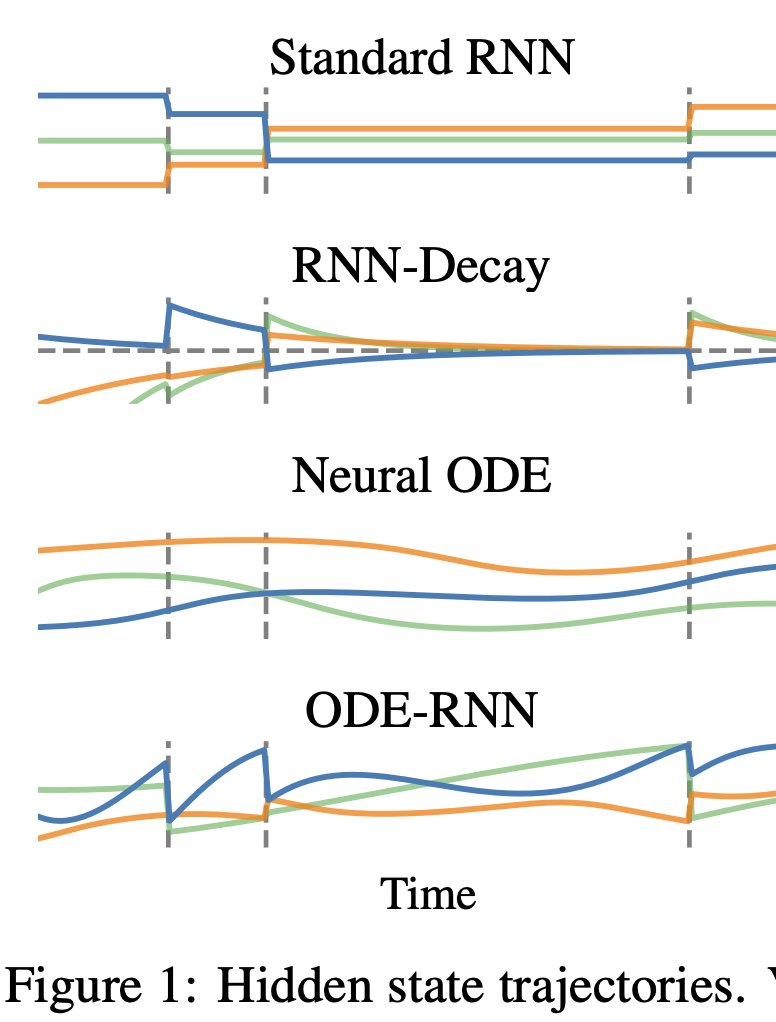Time-Continuous Neural Architectures
- irregularly measured time series
- previous solutions:
- attach timestamps to observations
- missing values -> GRU-D (informative missingness) link
- simple exponential decay between observations
- hidden state 𝑧(𝑡) ∈ 𝒵 that evolves continuously in time with potentially discontinuous updates when a new observation is made
- between two observation times, the hidden state evolves according to a set of flow curves
- explicitly modeling interventions? -> causality
- Training
- Adjoint method
- lower memory costs, less accurate
- Backpropagation-Through-Time
- vanishing/exploding gradients problem -> gates
- Adjoint method
Continuous-time recurrent neural networks
- any continuous curve can be approximated by the output of a recurrent neural network.
- outcome distribution 𝑃𝜽, neural networks: 𝑁𝑁𝑖𝑛𝑖𝑡, 𝑁𝑁𝑗𝑢𝑚𝑝, 𝑁𝑁𝑜𝑢𝑡 and flow 𝐹x,ϕ,
- initialization:
- 𝑧(𝑡0 ) = 𝑁𝑁𝑖𝑛𝑖𝑡 (𝑥0 )
- Update: With new observation vector 𝒉𝑡 set:
- 𝑧(𝑡) = 𝑁𝑁𝑗𝑢𝑚𝑝(𝒉𝒕 , 𝑧(𝑡−))
- Evolve:
- 𝑧(𝑡 + Δ𝑡 ) = 𝐹x,ϕ(𝑧(𝑡),𝑡 + Δ𝑡 )
- Forecast
- y = 𝜽 = 𝑁𝑁𝑜𝑢𝑡(𝑧(𝑡 + Δ𝑡))
- the distinctions lie in the architecture of the sub-networks and which inputs and hidden states are passed to the sub-networks!
- original article (hard-to-read) link
-
article (overview) link
- CT-GRU:
- replace the GRU storage (update gate) and retrieval (reset) gates with storage and retrieval scales, computed from the external input and the current hidden state
- (context-dependent) time scale is expressed in terms of a time constant -> exponential decay
- article (good intro) link
- exponential decay dynamics did not improve predictive performance over standard RNN approaches
- CT-LSTM:
- LSTM: input gate, forget gate, output gate
- same approach
- a decay term proportional to the time interval between events -> affects gates
- article link
Neural ODEs
- instead of the hidden state parameterize the derivative of the hidden state
- treating the neural network as the solution to an ordinary differential equation
- model the vector field associated with the flow curves using a neural network
- 𝑑𝑧 / 𝑑𝑡 = 𝑁𝑁𝑣𝑒𝑐(𝑧(𝑡)),
- 𝑧(𝑡1 ) = 𝑧(0) + ∫ 𝑁𝑁𝑣𝑒𝑐(𝑧(𝑠))𝑑𝑠 -> ODE solver
- choice of ODE solver enables adaptive computation (speed <-> accuracy)
-
article link
- article (10/10) link
- ODE-RNN:
-
neural ODE evolution of the hidden state between observations

-
- Autoregressive ODE models
-
p(x) = Product(i pθ(xi xi−1, . . . , x0)) - simple ODE-RNN to predict next time step
- dynamics and the conditioning on data are encoded implicitly through the hidden state updates
- hard to interpret
-
- Latent ODE
- VAE-like structure/training
- first: RNN recognition model
- later: ODE-RNN recognition model -> better representation -> extrapolation
- represents state explicitly through state
- represent dynamics explicitly through a generative model
- Latent states can be used to compare different time series, for e.g. clustering or classification tasks
- dynamics functions can be examined to identify the types of dynamics present in the dataset

- augmentation:
- Poisson process to model observation frequency
- ODE-LSTM
- LSTM ODE in recognition model
- long-term dependencies
- similar: GRU-ODE appeared in Latent ODE paper
- evolve the hidden state h(t) with an ODE, until observe new xt1
- use GRU-cell to update at that point
- article (10/8) link
- improving performance:
Neural flows
- different: Continuous Normalizing Flows (CNF)
- normalizing flows video link
- Neural ODEs: moving from a discrete set of layers to a continuous transformation simplifies the computation of the change in normalizing constant (Jacobian) -> efficiency
- better accuracy, faster convergence, more interpretable normalizing flow models
- stochastic estimation of trace (even more efficiency) link
- attentive CNF: attention mechanism
- neural network to directly parameterize the flow curves
- computational efficiency
- 𝑧(𝑡1 ) = 𝑁𝑁𝑓𝑙𝑜𝑤(𝑧(0), (𝑡0,𝑡1 ))
- condition: 𝑁𝑁𝑓𝑙𝑜𝑤 is invertible!
- Linear Flow
- F(t, x0) = exp(At)x0
- ResNet Flow
- F(t, x) = x + ϕ(t)(g(t, x))
- ϕ(t): activation; g(t, x): neural network
- residual layer xt+1 = xt + g(xt) -> resemblance to ODE-solve
- GRU Flow
- time series data
- flow version of GRU-ODE: can be rewritten into the form of a single Residual layer
- F(t, h) = h + r(t)(1 − z(t, h)) (c(t, h) − h)
- append xt to the input of z, r and c -> a continuous-in-time version of GRU
- Coupling Flow
- ResNet flow, GRU flow -> missing analytical inverse
- splitting the input dimensions into two disjoint sets A and B
- F(t, x)A = xA exp(u(t, xB)ϕu(t)) + v(t, xB)ϕv(t)
- ϕ or r : “time embedding function”
- Linear Flow
- Latent Variable models (VAE)
- Encoder: ODE-LSTM with flow instead of ODESolve
- Decoder: simply pass the next time point into F and get the next hidden state directly
- Continuous Normalizing Flows (CNF)
- coupling flow allows for more efficient computation
- article link
Interesting Related Topics
-
Augmented NODE, Second Order NODE link
- Temporal Point Processes: link
- the times at which we observe the events come from some underlying process, which we model
- Marked point processes: what type of an event happened
- Neural Jump Stochastic Differential Equations link
-
Spatio-Temporal Point Processes: link
- Flow based models
- Continually Learning Recurrent Neural Network link link